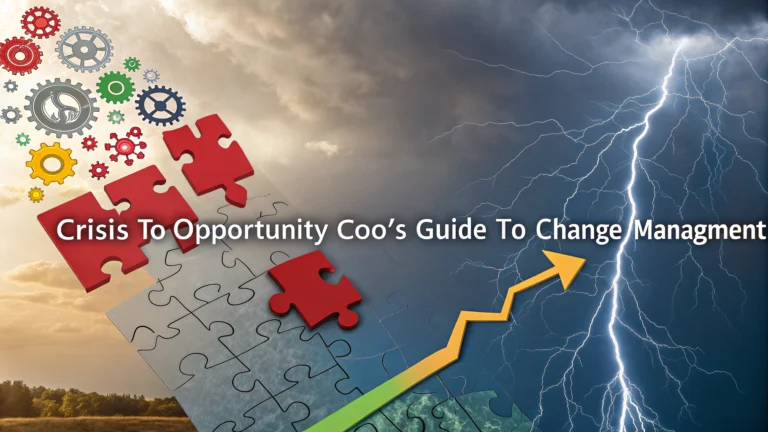Leading through organizational change requires a unique blend of strategic thinking and empathetic leadership from Chief Operating Officers.
Change management presents both significant challenges and opportunities for growth, requiring careful planning and execution to maintain operational efficiency while transforming business processes.
This guide outlines practical strategies for COOs to navigate change effectively, minimize disruption, and maximize positive outcomes.
Identifying the Need for Change
A thorough assessment of current operations, market conditions, and internal feedback helps determine where change is needed.
- Performance metrics falling below targets
- Customer satisfaction declining
- Employee engagement dropping
- Technology becoming obsolete
- Market share decreasing
Creating a Change Management Framework
Successful change initiatives require a structured approach with clear objectives and measurable outcomes.
- Define specific goals and objectives
- Establish timeline and milestones
- Allocate resources effectively
- Identify key stakeholders
- Create communication channels
Building Your Change Management Team
Select individuals who demonstrate both technical expertise and strong leadership capabilities.
- Change champions from each department
- Project managers with proven track records
- HR representatives for employee support
- IT specialists for technical implementations
Communication Strategies
Clear, consistent communication forms the backbone of successful change management.
| Stakeholder | Communication Method | Frequency |
|---|---|---|
| Executive Team | Strategic Updates | Weekly |
| Middle Management | Implementation Details | Bi-weekly |
| Employees | Progress Reports | Monthly |
Managing Resistance
Address resistance proactively through open dialogue and inclusive decision-making.
- Hold regular feedback sessions
- Document and address concerns promptly
- Provide training and support resources
- Celebrate small wins and progress
Measuring Success
Track progress using both quantitative and qualitative metrics.
- Employee adoption rates
- Productivity metrics
- Customer satisfaction scores
- ROI measurements
- Timeline adherence
Best Practices for Sustainable Change
Implement these proven strategies to ensure lasting transformation.
- Document processes and procedures
- Establish ongoing training programs
- Create feedback loops
- Monitor and adjust as needed
- Build change management into company culture
Resources and Tools
Utilize these professional resources for additional support:
- Change Management Institute (www.change-management-institute.com)
- Project Management Institute (www.pmi.org)
- Association of Change Management Professionals (www.acmpglobal.org)
Taking Action: Your Next Steps
Begin your change management journey with these immediate actions:
- Assess current state and identify gaps
- Build your change management team
- Create your communication plan
- Set clear metrics for success
- Schedule regular review meetings
Implementing Technology Solutions
Leverage digital tools and platforms to streamline change management processes and track progress.
- Change management software solutions
- Project tracking platforms
- Communication tools
- Data analytics dashboards
- Automated reporting systems
Risk Management Strategies
Identify and mitigate potential risks throughout the change process.
- Regular risk assessments
- Contingency planning
- Resource allocation buffers
- Stakeholder impact analysis
- Performance monitoring systems
Employee Development and Training
Skills Assessment
Evaluate current capabilities and identify training needs.
Training Programs
Develop comprehensive training initiatives to support new processes.
- Online learning modules
- Hands-on workshops
- Mentoring programs
- Skills certification
Securing Long-term Success
Transform organizational change into lasting improvements through systematic implementation.
- Embed new processes into daily operations
- Create accountability frameworks
- Maintain continuous improvement cycles
- Foster innovation culture
- Develop change resilience
Empowering Future Growth
Transform change management expertise into a competitive advantage for sustainable business success.
- Build internal change management capabilities
- Develop adaptive leadership skills
- Create scalable frameworks
- Establish knowledge management systems
- Foster organizational agility
FAQs
- What is the primary role of a COO in change management?
The COO is responsible for executing organizational change strategies, aligning operational processes with new initiatives, and ensuring smooth transition while maintaining business continuity. - How should a COO communicate change effectively across the organization?
A COO should implement a clear communication strategy that includes regular updates, transparent messaging, multiple communication channels, and two-way feedback mechanisms to address concerns and gather input. - What are the key steps in developing a change management plan?
The key steps include assessing current state, identifying gaps, setting clear objectives, creating a detailed implementation timeline, establishing metrics for success, developing risk mitigation strategies, and creating a stakeholder engagement plan. - How can a COO minimize resistance to change among employees?
By involving employees early in the process, providing adequate training and support, addressing concerns promptly, celebrating quick wins, and demonstrating the benefits of change through concrete examples. - What metrics should COOs track during organizational change?
Key metrics include employee engagement levels, productivity indicators, customer satisfaction scores, implementation milestones, cost savings, revenue impact, and adoption rates of new processes or systems. - How can COOs ensure operational stability during major organizational changes?
By implementing changes in phases, maintaining clear documentation of processes, establishing contingency plans, monitoring key performance indicators, and ensuring adequate resources are available throughout the transition. - What role does technology play in successful change management?
Technology serves as an enabler by providing tools for project management, communication, data analysis, process automation, and tracking progress while facilitating collaboration across departments. - How should COOs handle failed change initiatives?
COOs should conduct thorough post-mortems, document lessons learned, identify root causes of failure, adjust strategies accordingly, maintain transparent communication about setbacks, and develop revised approaches based on findings. - What are the essential skills a COO needs for effective change management?
Essential skills include strategic thinking, leadership, communication, stakeholder management, problem-solving, decision-making under pressure, and the ability to balance multiple priorities while maintaining focus on core business operations. - How can COOs align change initiatives with company culture?
By understanding existing cultural values, involving cultural champions, adapting change approaches to fit organizational norms, and ensuring new initiatives complement rather than contradict established company values.
